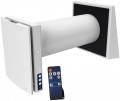Minimum air flow (ventilation)
The lowest performance with which the supply-exhaust unit can operate.
For performance in general, see "Maximum air flow". Here we note that it makes sense to indicate the minimum flow only in cases where the amount of air passed can be regulated (see "Number of fan speeds"). And even then, for such models, this parameter is not always given.
Maximum air flow (ventilation)
The highest performance of the air ventilation unit; or, if the air flow control is not provided for in the design, the nominal capacity of the unit.
In this case, air flow refers to the amount of air that the unit can pass through itself per hour. The optimal air flow value for each room is calculated by the formula "room volume multiplied by the air exchange rate"; the air flow must not be lower than this indicator; otherwise, we cannot talk about effective ventilation. The volume is easy to calculate by multiplying the area of the room by the height of the ceilings, and the multiplicity indicates how many times per hour the air in the ventilated space should be updated. It depends on the type and purpose of the room: for example, a multiplicity of 1 is enough for a residential apartment, and at least 4 is required for a pool (there are special tables by which you can determine the multiplicity for each type of room). Thus, for example, for an apartment with a living area of 70 m², a ceiling height of 2.5 m and a kitchen of 9 m² (air exchange rate of at least 2), a duct of at least 70*2.5*1+9*2.5*2=220 m³ (excluding bathroom and toilet, they have their requirements for multiplicity).
It should be noted that a certain flow margin (about 10–15%) will not be superfluous, but it hardly makes sense to chase higher rates — after all, performance requires appropriate power, which, in turn, affects the dimensions, price and
...energy consumption of the installation. Heat exchanger efficiency
Efficiency of the heat exchanger used in the heat exchanger of the supply and exhaust system (see "Features").
Efficiency is defined as the ratio of useful work to the energy expended. In this case, this parameter indicates how much heat taken from the exhaust air, the heat exchanger transfers to the supply air. The efficiency is calculated by the ratio between the temperature differences: you need to determine the difference between the outdoor air and the supply air after the heat exchanger, the difference between the outdoor and exhaust air, and divide the first number by the second. For example, if at an outside temperature of 0 °С, the temperature in the room is 25 °С, and the heat exchanger produces air with a temperature of 20 °С, then the efficiency of the heat exchanger will be (25 – 0)/(20 – 0)= 25/20 = 80%. Accordingly, knowing the efficiency, it is possible to estimate the temperature at the outlet of the heat exchanger: the temperature difference between the inside and outside must be multiplied by the efficiency and then the resulting number is added to the outside temperature. For example, for the same 80% at an outdoor temperature of -10 °C and an internal temperature of 20 °C, the inflow temperature after the heat exchanger will be (20 – -10)*0.8 + -10 = 30*0.8– 10 = 24 – 10 = 14 °C.
The higher the efficiency, the more heat will be returned to the room and the more savings on heating will be. At the same time, a highly efficient heat e...xchanger is usually expensive. Also note that the efficiency may vary slightly for certain values of the external and internal temperatures, while manufacturers tend to indicate the maximum value of this parameter — accordingly, in fact, it may turn out to be lower than the claimed one.
Control via Internet
Ability
to control device via the Internet. The connection of the unit to the World Wide Web, usually, is carried out via Wi-Fi, and the control format may be different: in some models, you need to use a special application installed on your smartphone or tablet; in others, it is enough to open a special page in a browser. Anyway, this function allows you to control the device from anywhere in the world where there is Internet access, as well as, monitor its status and receive notifications about various operating parameters (current power, outdoor temperature, failures and malfunctions, etc.).
Power consumption in ventilation mode
The electrical power consumed by the supply and exhaust unit in normal operating mode (for models with adjustable performance — at maximum speed) can help determine the connection requirements for the unit and estimate the cost of operation in terms of electricity bills. It should be noted that for models with an electric reheater (see "Reheater type"), this refers only to the power of the ventilation system, while the power of the reheater is provided separately (see above). Therefore, the total energy consumption during full operation will correspond to the sum of these power values.
The power consumption can also be used to some extent to assess the unit's performance: "power-hungry" units usually provide a corresponding airflow.

